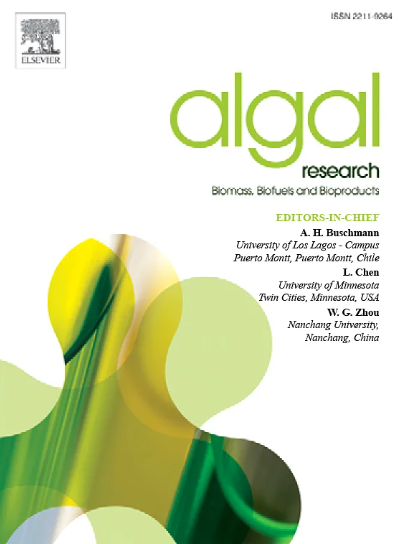Iodine reduction and retention of nutrients and flavour-active compounds upon warm seawater treatment of the kelps Alaria esculenta and Saccharina latissima
IF 4.6
2区 生物学
Q1 BIOTECHNOLOGY & APPLIED MICROBIOLOGY
Algal Research-Biomass Biofuels and Bioproducts
Pub Date : 2025-02-16
DOI:10.1016/j.algal.2025.103969
引用次数: 0
Abstract
Commercially cultivated kelp (seaweed) species represent a potential dietary source of iodine but may also put consumers at risk of excessive intakes upon frequent consumption. This study investigated warm seawater (W-SW) treatment as a simple method for reducing the iodine content of Alaria esculenta and Saccharina latissima. Iodine concentrations decreased in both kelps upon W-SW exposure at 45 °C, i.e. by 38 % and 78 %, respectively, in A. esculenta and S. latissima after 1 min and 51 % and 88 % after 2 min. Longer treatments resulted in further decrease in A. esculenta whereas only marginal further reduction in iodine concentrations were achieved in S. latissima. No reduction in iodine concentration was measured in S. latissima following treatment at 35 °C (not tested for A. esculenta). W-SW treatment at 45 °C induced loss of biomass in both kelps although the total retention was notably higher in A. esculenta compared to S. latissima. Among the analysed macronutrients, potassium and mannitol were associated with the lowest retentions. Losses of micronutrients (incl. vitamin B1 and B9) and trace elements were also measured in both kelps. The retention of free glutamate was high in both species suggesting that W-SW exposure does not negatively affect the umami potential of the final ingredients for food. Based on portions contributing 600 μg iodine, W-SW-treated A. esculenta was more nutritious than a comparable ingredient from S. latissima, with nutritionally relevant contribution (> 15 % of dietary reference intake (DRI)) per portion (4.6 g dry A. esculenta vs. 1.2 g S. latissima) of sodium, and notable contributions (> 5 % of DRI) of other minerals (calcium, magnesium and potassium) and vitamin B9. Short W-SW treatment is a simple approach that could be implemented in commercial kelp production and contribute to reducing the risk of excessive dietary iodine exposure from seaweed consumption.
求助全文
约1分钟内获得全文
求助全文
来源期刊

Algal Research-Biomass Biofuels and Bioproducts
BIOTECHNOLOGY & APPLIED MICROBIOLOGY-
CiteScore
9.40
自引率
7.80%
发文量
332
期刊介绍:
Algal Research is an international phycology journal covering all areas of emerging technologies in algae biology, biomass production, cultivation, harvesting, extraction, bioproducts, biorefinery, engineering, and econometrics. Algae is defined to include cyanobacteria, microalgae, and protists and symbionts of interest in biotechnology. The journal publishes original research and reviews for the following scope: algal biology, including but not exclusive to: phylogeny, biodiversity, molecular traits, metabolic regulation, and genetic engineering, algal cultivation, e.g. phototrophic systems, heterotrophic systems, and mixotrophic systems, algal harvesting and extraction systems, biotechnology to convert algal biomass and components into biofuels and bioproducts, e.g., nutraceuticals, pharmaceuticals, animal feed, plastics, etc. algal products and their economic assessment
 求助内容:
求助内容: 应助结果提醒方式:
应助结果提醒方式:


